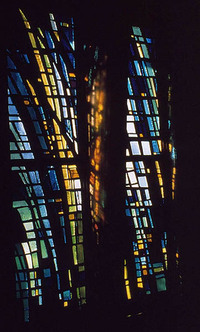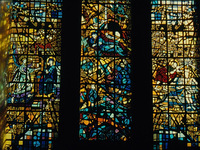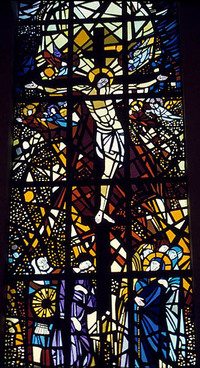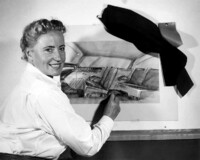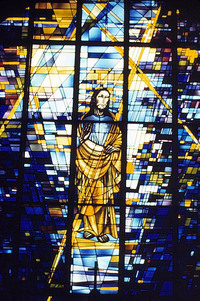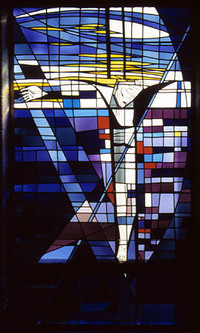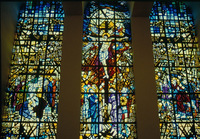MSGC : Featured Windows : Current Window
Featured Windows, June 2007
Helene Rother (1908-1999)
Buildings:
Trinity United Methodist Church - Lapeer, Michigan
Lapeer Regional Medical Center - Lapeer, Michigan
Edgewood United Church - East Lansing, Michigan
St. Lazarus Serbian Orthodox Cathedral - Detroit, Michigan
Nardin Park United Methodist Church - Farmington Hills, Michigan
St. Lazarus Serbian Orthodox Cathedral, Detroit. MSGC 94.0120.
Some years ago when the Michigan Stained Glass Census was in its early years, two different churches in metropolitan Detroit registered windows designed by Helene Rother. Neither church had much information about Ms. Rother, which resulted in a yearlong attempt to find information about her. As it turned out, Helene Rother was living not far away, in the Metamora area in the northern suburbs of Detroit. She invited us to visit her home, where she had a storage attic filled with maquettes of her earlier stained glass work, some of which she immediately donated to the Michigan Stained Glass Census.
A native of Leipzig, Germany, Helene Rother studied art at the Kunstgewerbe School in Hamburg. She then studied at the well known
Bauhaus School, an academy of art and design in Weimar, Germany where many of the best known mid-century designers also attended. Ms. Rother stated that she studied metal craft, enamels and goldsmithing. When contacted, the Bauhaus had no records of Ms. Rother, due to damage inflicted during World War II
1. Ms. Rother moved to Paris and became involved in the design of high fashion jewelry, in association with the Studio Contempora. She designed and marketed some of the very popular little animal pins women wore on hats and dresses before World War II
2.
Helene Rother with one of her automotive interior designs, ca. 1950. MSGC 93.0116.
As the Nazis approached Paris, Ms. Rother and her seven-year-old daughter Ina fled to a refugee camp in northern Africa where they stayed for four months before finding passage on a ship bound for New York in 1941
3. Her first employment in New York was as an illustrator for Marvel Comics
4. News articles found in the art collection of the Detroit Public Library provide information that "letters had been received from a general" asking her to design fashion interiors for automobiles. Eventually, as the story was told, the "general" was the major automotive company, General Motors. Ms. Rother and daughter Ina moved from New York to Detroit where she was soon responsible for upholstery colors and fabrics, lighting, door hardware and seat construction
5. She was Detroit's first woman automotive designer, something downplayed at the time. Her salary as reported in the newspaper was $600 a month
6. Ms. Rother worked for General Motors for about four years when she decided to become a freelance designer. She purchased a home on Chicago Boulevard, with a studio downstairs and living quarters upstairs
7. Her first account was with Nash Kelvinator Corporation where she did similar work as she had done for General Motors.
At some point after the war, Ms. Rother decided she wanted to begin producing art again. As mentioned in a newspaper article, she went for a visit to Europe. While there she saw first hand what some of her acquaintances were doing in their struggle to restore or rebuild war-damaged churches and cathedrals
8. Somehow she made contact with a French studio that eventually would fabricate her stained glass windows in Michigan. In her MSGC interview, Ms. Rother related that she was leery of trying to sell "modern" stained glass to American churches, but was surprised at her success. One of her most spectacular installations was in the mid 1960s in conjunction with architect Harold Fisher for St. Lazarus Serbian Orthodox Cathedral in northeast Detroit
9. The windows are all faceted glass, fabricated in France
10.
In 2003, several years after her mother's death, Dr. Ina Rother donated her mother's remaining stained glass collection to the Michigan Stained Glass Census. Among the items were about 50 maquettes and sketches of many of her Michigan installations, and newspaper articles and a scrapbook about Ms. Rother and her involvement with the automotive industry. Also included were drawings from contemporary French stained glass artists, ca. 1960s, which, in lieu of an explanation, must have been given to Ms. Rother who brought them back to Detroit. Additional research needs to be done on the French artists.
Left: Edgewood United Church, East Lansing. MSGC 92.0004.
Right: Nardin Park United Methodist Church, Farmington Hills. MSGC 93.0081.
Even though Helene Rother remains relatively unknown in the world of stained glass, she is beginning to be recognized for the role she played in the world of women in the automotive business. For the most part, the church congregations where her work is extant know little or nothing about her, as women who designed stained glass, either independently or under a major studio name, were for the most part unrecognized at the time.
Left: Trinity United Methodist Church, Lapeer. MSGC 94.0127.
Right: Lapeer Regional Hospital, Lapeer. MSGC 01.0037.
Other Michigan churches with windows designed by Helene Rother are: Beverly Hills United Methodist Church, Beverly Hills; St. Andrews Catholic Church, Detroit; Edgewood United Church, East Lansing; Nardin Park Methodist Church, Farmington Hills; and Trinity United Methodist Church, Lapeer.
Notes:
1Rother, Helene. Interview with author, 1994.
2ibid.
3ibid.
4Foster, Patrick. "Helene Rother: First Lady of Style."
Hemmings Motor News (Bennington, VT). 1 July, 2005.
5Detroit Public Library (Art and Literature Department), photo/reference files.
6Foster.
7Rother, Helene. Interview with author, 1994.
8ibid.
9Rother, Ina. Interview with author, 15 April, 2003.
10St. Lazarus Serbian Orthodox Cathedral Ravanica. "The Architectural History of St. Lazarus Serbian Orthodox
Cathedral Ravanica" (2007).
http://www.ravanica.com/archit.htm (MSGC 1992.0004, 1994.0120, 1993.0116, 1993.0081, 1994.0127, 2001.0037)
Text by Krueger, Barbara, Michigan Stained Glass Census, June , 2007.

